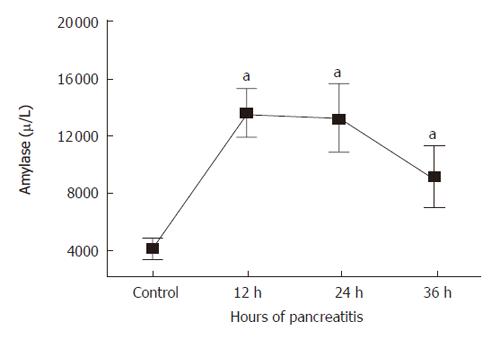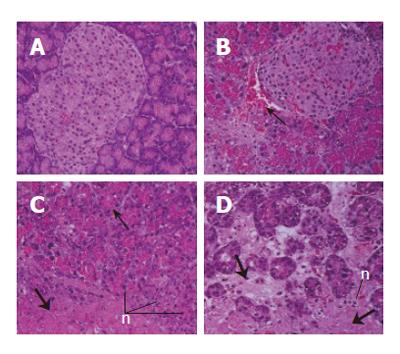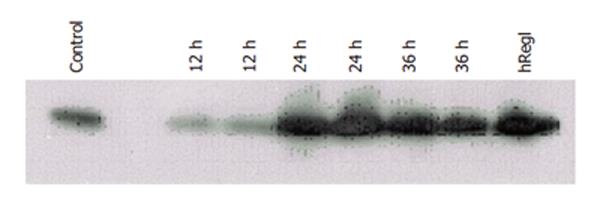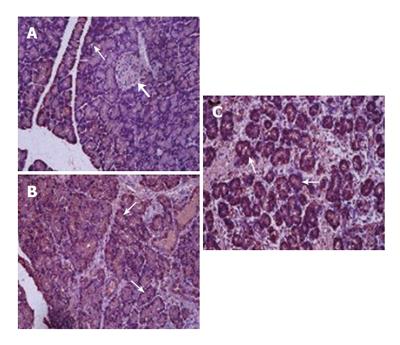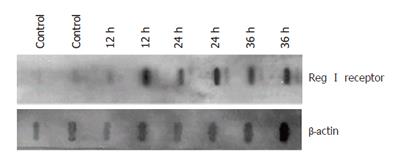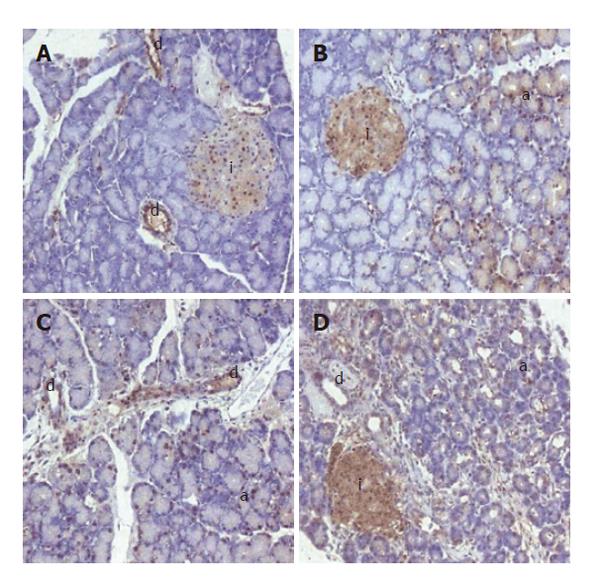Published online Jul 28, 2006. doi: 10.3748/wjg.v12.i28.4511
Revised: January 2, 2006
Accepted: January 14, 2006
Published online: July 28, 2006
AIM: Pancreatic regenerating protein (regI) stimulates pancreatic regeneration after pancreatectomy and is mitogenic to ductal and β-cells. This suggests that regIand its receptor may play a role in recovery after pancreatic injury. We hypothesized that regIand its receptor are induced in acute pancreatitis.
METHODS: Acute pancreatitis was induced in male Wistar rats by retrograde injection of 3% sodium taurocholate into the pancreatic duct. Pancreata and serum were collected 12, 24, and 36 hours after injection and from normal controls (4 rats/group). RegIreceptor mRNA, serum regIprotein, and tissue regIprotein levels were determined by Northern analysis, enzyme-linked immunosorbent assay (ELISA), and Western analysis, respectively. Immunohistochemistry was used to localize changes in regIand its receptor.
RESULTS: Serum amylase levels and histology confirmed necrotizing pancreatitis in taurocholate treated rats. There was no statistically significant change in serum regIconcentrations from controls. However, Western blot demonstrated increased tissue levels of regIat 24 and 36 h. This increase was localized primarily to the acinar cells and the ductal cells by immunohistochemistry. Northern blot demonstrated a significant increase in regIreceptor mRNA expression with pancreatitis. Immunohistochemistry localized this increase to the ductal cells, islets, and acinar cells.
CONCLUSION: Acute pancreatitis results in increased tissue regIprotein levels localized to the acinar and ductal cells, and a parallel threefold induction of regIreceptor in the ductal cells, islets, and acinar cells. These changes suggest that induction of regIand its receptor may be important for recovery from acute pancreatitis.
- Citation: Bluth MH, Patel SA, Dieckgraefe BK, Okamoto H, Zenilman ME. Pancreatic regenerating protein (reg I) and reg I receptor mRNA are upregulated in rat pancreas after induction of acute pancreatitis. World J Gastroenterol 2006; 12(28): 4511-4516
- URL: https://www.wjgnet.com/1007-9327/full/v12/i28/4511.htm
- DOI: https://dx.doi.org/10.3748/wjg.v12.i28.4511
Since its isolation in 1988 by Terazono et al[1], much work has been done to elucidate the function of the regeneration protein, reg I. RegIprotein appears to function as a growth factor in the pancreas, as evidenced by its structural similarity to calcium-dependant lectins[2], as well as its mitogenic effect on beta and ductal pancreatic cell lines[3] and its ability to reverse surgically induced diabetes[4,5]. RegIgene expression has also been found in other tissues including gastric cells[6], and rats with water immersion stress induced gastric lesions demonstrate an increase in regIexpression in gastric enterochromaffin-like cells during healing[7]. RegIis therefore involved in the regeneration and growth of gastrointestinal tissue. Furthermore, acute pancreatitis induces regIgene expression and protein production in the pancreas[8,9]. Recently, Kobayashi et al isolated the gene for regIreceptor[10], which is part of the exostoses family of genes. Transfection of the gene into the pancreatic β-cell line RINm5F cells resulted in increased mitogenesis after exposure to regIprotein.
Since regIand its receptor are linked to cellular mitogenesis and may affect repair of damaged pancreas, we examined the role of their expression in acute pancreatitis.
Acute necrotizing pancreatitis was induced in male Wistar rats using a 30 g/L sodium taurocholate solution according to a protocol described by Aho et al with slight modification[11]. The animals (4 rats/group) were anesthetized with a 1:1 mixture of ketamine (100 mg/mL) and xylazine (20 g/L) dosed at 0.1 mL per 100 g of body mass injected subcutaneously. The abdominal cavity was then entered through a midline incision. The duodenum and pancreas were identified, the common biliopancreatic duct ligated at the hilum of the liver, and a duodenostomy made approximately 1 cm distal to the opening of the biliopancreatic duct into the duodenum. A polyethylene catheter with an inner diameter of 0.58 mm and an outer diameter of 0.965 mm was used to cannulate the pancreatic duct through the duodenostomy. A 30 g/L sodium taurocholate solution was slowly injected at a dose of 1 mL/kg at a constant infusion rate of 0.5 mL/min. The catheter was left in place for 30 min and then removed. The midline incision was then closed in a single layer closure. Control animals consisted of sham operated rats (open laparotomy with immediate closure) and healthy rats.
A total of 12 rats were operated on for induction of pancreatitis. Four rats were sacrificed at each time point (12, 24, and 36 h). Four rats per group (unoperated and sham operated) were used for controls. The pancreas was harvested and blood collected by cardiac puncture from each rat. A small portion of the head of the pancreas was fixed in formalin and sent for staining with hematoxylin and eosin (HE) and immunohistochemical staining with regImAb[12]. The remaining pancreas was divided in half. One portion was immediately snap-frozen in liquid nitrogen and used for RNA isolation (below), and the other for protein isolation. This was performed by homogenization in buffer containing 125 mmol/L mannitol, 40 mmol/L sucrose, 5 mmol/L ethylenediaminetetraacetic acid (EDTA), and 5 mmol/L piperizine ethane sulfuric acid-Tris (PIPES-Tris) (pH 6.7). The homogenate was centrifuged at 4100 g for 30 min and the supernatant collected and frozen at -20°C. The concentration of total protein in the pancreas homogenates was quantified using the BioRad Protein Assay solution according to the manufacturer’s protocol. The blood was centrifuged at 1800 g for 15 min. The supernatant (serum) was collected and stored at -20°C.
Serum amylase activity was determined by enzymatic reaction. Formaldehyde-fixed pancreatic specimens from each rat were stained with HE.
Preparation of regIcDNA probe
RegIcDNA probe was prepared by PCR using a plasmid with a regIinsert as a template[3]. The sequences of the oligonucleotide primers are 5’ACGCGTCGACTCATGACTCGCAACAAATATTTC3’ and 5’GGCACTGCAGTCAGGCTTTGAACTTGCAGAC3’. The PCR was carried out using digoxigenin-labeled uridine triphosphate (DIG-labeled UTP) (Roche Diagnostics, Mannheim, Germany) under the following conditions: denaturing at 94°C for 30 s, annealing at 57°C for 30 s, and elongation at 72°C for 1 min; 30 cycles were used.
Preparation of RegIreceptor cDNA probe
A RegIreceptor cDNA was prepared using double digestion of pCIneo-RegIreceptor cDNA plasmid [10] with HindIII and NotI. Electrophoresis of the digestion complex was performed on 8 g/L agarose gel, the receptor band cut from the gel, and the cDNA extracted from the gel using the QIAEX II agarose gel extraction protocol (Qiagen, Valencia, CA). The regIreceptor cDNA fragment was labeled with digoxigenin (DIG) using the DIG High Prime DNA Labeling and Detection Starter Kit II (Boehringer Mannheim, Germany) as per manufacturers’ protocol.
RNA was extracted from rat pancreatic and intestinal tissue using Trizol reagent (Gibco, Life Technologies, Rockville, MD). RNA extraction was performed with 1-bromo-3-chloropropane. RNA concentrations were determined by absorbance measurements at 260 nm, and the integrity confirmed by polyacrylamide gel electrophoresis. Equal amounts (20 μg) of total RNA were then used for all Northern blots. The membrane was equilibrated in 10 × saline-sodium citrate (SSC) buffer for 5 min. The RNA samples were prepared as follows: 50 μL TE buffer (TE: 10 mmol/L Tris, 0.1 mmol/L EDTA, pH 8.0), 20 μL of 37 g/L formaldehyde, 30 μL of 20 × SSC, and 20 μg RNA. The samples were heated at 60°C for 15 min and immediately chilled on ice for 3 min. Two hundred microliters of 10 × SSC were then added to each tube. The samples were applied to the nylon membrane using a Northern slot blot apparatus. Each well was washed with 500 μL SSC. The membrane with RNA was UV cross-linked and placed in 50 mL of DIG pre-hybridization solution at 48°C for 6 h. Hybridization with the DIG-labeled regIreceptor cDNA probe was carried out at 58°C for 12 h. After washing and blocking, the membrane was incubated in a 1:10 000 dilution of anti-DIG-alkaline phosphatase conjugate antibody solution at room temperature for 30 min. CSPD solution (Boehringer Mannheim) was used for detection. Gels were photographed using Polaroid 667 film and digitized using an Epson 636 scanner. Band density analysis was performed using the public domain NIH Image program (available at http://rsb.info.nih.gov/nih-image/) to determine the quantity of nucleic acid product. To account for differences in the amounts of starting RNA between samples, the density of each reg band was normalized to that of the β-actin band for the same sample. Samples were run in duplicate and data are expressed as mean optical densitometric (OD) measurements ± SE.
Western blot on tissue homogenate to determine regIlevels
The tissue was homogenized in buffer containing 125 mmol/L mannitol, 40 mmol/L sucrose, 5 mmol/L EDTA, 5 mmol/L PIPES-Tris (pH 6.7), and 1 tablet of protease inhibitor cocktail per 50 mL of buffer. Total protein concentrations were determined using Bio-Rad protein assay. Electrophoresis was performed using equal amounts of total protein (10 μg/well) in a 100 g/L sodium dodecyl sulphate polyacrylamide gel (SDS-PAGE). The electrophoresis was carried out at 80 V for the first 15 min and then at 130 V for 45 min in SDS electrophoresis buffer. The protein was transferred to nitrocellulose membrane (Micron Separations, Inc., Westborough, MA) at 100 V for 1 h. The membrane was blocked overnight in 50 mL/L milk. A dilution of 1:5000 was used for the mouse anti-regImAb and incubated for 1 h with the membrane. After washing with T-TBS, the membrane was incubated for 45 min with a 1:2000 dilution of horse radish peroxidase-linked anti-mouse IgG. Detection was done using the ECL Western Blotting Detection System (Amersham Pharmacia, Piscataway, NJ). Human Reg 1 (hReg1) (10 μg) was used as a positive antibody control.
ELISA on serum samples to determine regIconcentration
Each well of the microtiter plate was coated with a mixture of 50 μL serum and 50 μL of coating buffer (20 mmol/L Na2CO3 and 35 mmol/L NaHCO3). Serial dilutions of human regIwere used as standards. The wells were coated overnight, followed by blocking with a 3% BSA solution for 4 h. The mouse regImAb was diluted 1:1000 and incubated for 1 h[12,13]. A dilution of 1:1000 was used for the secondary antibody and incubated for 45 min. Detection was performed by adding 100 μL of detection buffer (4.84 mL of 0.05 citric acid, 5.14 mL of 0.1 Na2HPO4, 30 μL of 300 mL/L peroxide, and 1 tablet of o-phenylenediamine) and measuring absorbance at 450 nm.
Two non-overlapping peptide sequences were identified that were contained in the extracellular domain of the RegIreceptor[10] with predicted antigenicity and directly flanking specific amino acids thought to directly bind to RegI(phage display experiment, unpublished data). PAELEKQLYSLPHWRTDC and RLLPEKDDAGLPPPKATRGC were synthesized by solid phase synthesis (Biomolecules Midwest Inc., St. Louis, MO), purified by reverse phase high performance liquid chromatography (HPLC), and characterized by Mass Spectrometry. Peptides were coupled to KLH and used for immunization of rabbits. Rabbits were boosted at monthly intervals and bled 10-14 d after each boost. Antibody titer was determined in a microtiter plate ELISA using the conjugated peptide as the immobilized antigen. The immunoglobulin fraction was isolated using ImmunoPure (A/G) IgG purification system (Pierce, Rockford, IL) and the final antibody concentration was determined with the BCA Assay (Pierce).
RegIreceptor immunohistochemistry
Paraffin embedded sections were treated with Ficin (1:100 dilution, Sigma, St. Louis, MO) for 30 min at room temperature, washed, and were then treated with Avidin/Biotin blocking reagent (Vector Labs, Burlingame, CA) for 20 min. Slides were subsequently treated with a Protein Block Reagent (Dako, Carpenteria, CA) and incubated with primary antibodies overnight at 4°C. Goat anti-rabbit biotinylated IgG secondary antibody was applied for 1 h at room temperature (1:1500, NEN Life Science, Boston, MA). Endogenous peroxidase activity was quenched by treatment with 10 mL/L hydrogen peroxide/PBS and sections were then incubated with streptavidin-horseradish peroxidase (SA-HRP) (1:1000 dilution, Dako) for 30 min. For receptor experiments, tyramide amplification was applied for 3 min (NEN Life Science, Boston, MA). Slides were extensively rinsed and again incubated with SA-HRP (Dako, 1:1000) for 30 min at room temperature. Slides were developed in DAB (Sigma, St. Louis, MO) and counterstained with hematoxylin (Richard Allan, Kalamazoo, MI).
Data were expressed as means ± SE. Student’s t test was used for analysis. P < 0.05 was taken as significant.
The presence of acute necrotizing pancreatitis in taurocholate-treated rats was confirmed by serum amylase activity and histology (Figures 1 and 2). As demonstrated in Figure 1 serum amylase levels at 12, 24, and 36 h were elevated (P < 0.05) when compared to both sham operated and normal control rats. Figure 1 demonstrates a rapid increase in amylase levels at 12 h with a gradual decline towards normal levels at 24 and 36 h. Figure 2 demonstrates histopathological worsening of pancreatitis in the pancreatic parenchyma after sodium taurocholate treatment as evidenced by hemorrhage (Figures 2B, C) and necrosis (Figure 2D) when compared with control groups (Figure 2A).
Western blot analysis of pancreatic tissue showed a single band at 15-17 ku using a monoclonal antibody and demonstrated an increase in regIprotein in the 24 and 36 h pancreatitis groups compared to controls, although at 12 h, there was an initial decrease in regIprotein (Figure 3). Histologic examination showed that this appeared localized in the pancreatic acinar cells (Figure 4). Serum regIprotein levels were not significantly different in pancreatitis (0.43 ± 0.13 mg/L) when compared with sham-operated and normal controls (0.38 ± 0.15 mg/L) (data not shown).
Northern/slot blot analysis demonstrated a single band corresponding to the RegIreceptor mRNA and showed an increase in regIreceptor RNA expression in pancreatic tissue from the experimental pancreatitis groups compared to controls (Figure 5). Mean absorbance (A) ± SE of regIreceptor signals on Northern/slot blot for control, 12, 24, and 36 h of pancreatitis were 24 ± 6, 71 ± 15, 66 ± 26, and 75 ± 20 (all were significantly increased compared to control, P < 0.05). Immunohistochemical staining with anti-regIreceptor antibody showed that although staining persisted in the ductal population, there was significant induction of receptor protein in both the islets and acinar cells (Figure 6).
RegIis mitogenic to ductal and β-cells likely through the induction of the MAP kinase p38 pathway[14]. This has been shown to be true in both cell culture and animal models of pancreatectomized rats. The data presented support the hypothesis that regIis involved in regeneration after injury to the pancreas in the form of a sodium taurocholate-induced acute necrotizing pancreatitis. The pancreatitic rats demonstrated an increase in regIprotein levels in pancreatic tissue after 24 h of pancreatitis. In the acutely inflamed pancreas it appeared that regIprotein was overproduced in the acinar cell population. This is consistent with the findings of others in both acute and chronic forms of pancreatitis[15]. Although many genes are differentially regulated in inflammatory states, microarray data by us and others have demonstrated increased Reg expression in experimental pancreatitis[16,17]. Interestingly, serum regIprotein levels did not increase in parallel with acinar regIRNA expression levels[13]. This may be due to differences in cellular RNA turnover prior to stabilization of protein levels in serum, possibly through unidentified regIbinding proteins. Similar discord between protein and gene expression has been found in other systems[18].
Baseline expression of regIreceptor is present in pancreatic ductal and beta cell lines, but not in acinar cell lines[10,19]. These cells respond to regIprotein by proliferating, as measured by thymidine incorporation. Cells transfected with the receptor respond to regIin a similar fashion[10]. Acinar cells, which typically do not grow in response to reg I, do not express the receptor. It is therefore likely that the expression of the receptor is linked to the activity of cellular mitogenesis, and may be important in the proliferative response of pancreatic regeneration.
We found that pancreatitis significantly induced the expression of regIreceptor RNA in pancreatic tissue compared with baseline level. Immunohistochemical analysis with a polyclonal antibody to the regIreceptor localized the induced protein to the acinar cells and islets, and was only mildly present in ductal cells. This pattern of induction was in sharp contrast to the increase in regIwhich was initially induced primarily in the acinar cells. While ductal cells typically proliferate after pancreatitis[20], the additional induction of the protein in islets and acinar cells likely means that they are becoming responsive to the regIprotein which is being produced and secreted by the acinar cells.
Our present data suggest that increased regIprotein and receptor are important in the response of the pancreas to injury. Specifically, regImay exert its mitogenic effect on all the cell populations after injury. It likely works in a paracrine fashion, since it is produced and secreted from acinar cells. The induction of the receptor after injury in the acinar cells and islets and its maintenance of expression in the ductal cells may allow the protein to enhance its regenerative effect.
Another new protein induced in pancreatitis is reg III, or pancreatitis associated protein (PAP). Seventy percent homologous to reg I, the pancreatic RNA and protein levels are increased even more dramatically in pancreatitis, and PAP protein is also increased in serum [21,22]. We showed that the bovine form of reg III is mitogenic to pancreatic β- and ductal cells as well[3]. It is possible that reg III protein interacts with the regIreceptor which may provide an important pathway for regeneration after injury.
Future experiments need to determine whether blocking the receptor will block the regenerative effect of reg I, and whether other members of the reg family, in particular reg III, can stimulate the receptor as well.
We thank Dr. Albert Stanek for his assistance in his-topathology interpretation.
S- Editor Pan BR L- Editor Zhu LH E- Editor Ma WH
| 1. | Terazono K, Yamamoto H, Takasawa S, Shiga K, Yonemura Y, Tochino Y, Okamoto H. A novel gene activated in regenerating islets. J Biol Chem. 1988;263:2111-2114. [PubMed] |
| 2. | Peterson TE. The amino terminal domain of thrombomodulin and PSP are homologous with lectin. FEBS Lett. 1988;231:51-53. [RCA] [PubMed] [DOI] [Full Text] [Cited by in Crossref: 40] [Cited by in RCA: 42] [Article Influence: 1.1] [Reference Citation Analysis (0)] |
| 3. | Zenilman ME, Magnuson TH, Swinson K, Egan J, Perfetti R, Shuldiner AR. Pancreatic thread protein is mitogenic to pancreatic-derived cells in culture. Gastroenterology. 1996;110:1208-1214. [RCA] [PubMed] [DOI] [Full Text] [Cited by in Crossref: 66] [Cited by in RCA: 67] [Article Influence: 2.3] [Reference Citation Analysis (0)] |
| 4. | Terazono K, Uchiyama Y, Ide M, Watanabe T, Yonekura H, Yamamoto H, Okamoto H. Expression of reg protein in rat regenerating islets and its co-localization with insulin in the beta cell secretory granules. Diabetologia. 1990;33:250-252. [RCA] [PubMed] [DOI] [Full Text] [Cited by in Crossref: 98] [Cited by in RCA: 97] [Article Influence: 2.8] [Reference Citation Analysis (0)] |
| 5. | Watanabe T, Yonemura Y, Yonekura H, Suzuki Y, Miyashita H, Sugiyama K, Moriizumi S, Unno M, Tanaka O, Kondo H. Pancreatic beta-cell replication and amelioration of surgical diabetes by Reg protein. Proc Natl Acad Sci USA. 1994;91:3589-3592. [RCA] [PubMed] [DOI] [Full Text] [Cited by in Crossref: 192] [Cited by in RCA: 190] [Article Influence: 6.1] [Reference Citation Analysis (0)] |
| 6. | Perfetti R, Egan JM, Zenilman ME, Shuldiner AR. Differential expression of reg-I and reg-II genes during aging in the normal mouse. J Gerontol A Biol Sci Med Sci. 1996;51:B308-B315. [RCA] [PubMed] [DOI] [Full Text] [Cited by in Crossref: 19] [Cited by in RCA: 17] [Article Influence: 0.6] [Reference Citation Analysis (0)] |
| 7. | Asahara M, Mushiake S, Shimada S, Fukui H, Kinoshita Y, Kawanami C, Watanabe T, Tanaka S, Ichikawa A, Uchiyama Y. Reg gene expression is increased in rat gastric enterochromaffin-like cells following water immersion stress. Gastroenterology. 1996;111:45-55. [RCA] [PubMed] [DOI] [Full Text] [Cited by in Crossref: 87] [Cited by in RCA: 86] [Article Influence: 3.0] [Reference Citation Analysis (0)] |
| 8. | Iovanna JL, Keim V, Michel R, Dagorn JC. Pancreatic gene expression is altered during acute experimental pancreatitis in the rat. Am J Physiol. 1991;261:G485-G489. [PubMed] |
| 9. | Dusetti NJ, Mallo GV, Ortiz EM, Keim V, Dagorn JC, Iovanna JL. Induction of lithostathine/reg mRNA expression by serum from rats with acute pancreatitis and cytokines in pancreatic acinar AR-42J cells. Arch Biochem Biophys. 1996;330:129-132. [RCA] [PubMed] [DOI] [Full Text] [Cited by in Crossref: 46] [Cited by in RCA: 48] [Article Influence: 1.7] [Reference Citation Analysis (0)] |
| 10. | Kobayashi S, Akiyama T, Nata K, Abe M, Tajima M, Shervani NJ, Unno M, Matsuno S, Sasaki H, Takasawa S. Identification of a receptor for reg (regenerating gene) protein, a pancreatic beta-cell regeneration factor. J Biol Chem. 2000;275:10723-10726. [RCA] [PubMed] [DOI] [Full Text] [Cited by in Crossref: 135] [Cited by in RCA: 130] [Article Influence: 5.2] [Reference Citation Analysis (0)] |
| 11. | Aho HJ, Koskensalo SM, Nevalainen TJ. Experimental pancreatitis in the rat. Sodium taurocholate-induced acute haemorrhagic pancreatitis. Scand J Gastroenterol. 1980;15:411-416. [RCA] [DOI] [Full Text] [Cited by in Crossref: 239] [Cited by in RCA: 256] [Article Influence: 5.7] [Reference Citation Analysis (0)] |
| 12. | Wu H, Rengabashyam P, Patel S, Zheng Q, Zenilman ME. Administration of reg protein improves glucose tolerance in rats after pancreatic duct ligation (PDL). Gastroenterology. 2001;120:A720. [DOI] [Full Text] |
| 13. | Zenilman ME, Tuchman D, Zheng Q, Levine J, Delany H. Comparison of reg I and reg III levels during acute pancreatitis in the rat. Ann Surg. 2000;232:646-652. [RCA] [PubMed] [DOI] [Full Text] [Cited by in Crossref: 27] [Cited by in RCA: 29] [Article Influence: 1.2] [Reference Citation Analysis (0)] |
| 14. | Zenilman ME, Zheng Q, Wu H, Rengabashyam P. Pancreatic reg and a conserved bioactive fragment are mitogenic through the MAPK p38 pathway. Surg Forum. 2000;LI:33-34. [PubMed] |
| 15. | Satomura Y, Sawabu N, Ohta H, Watanabe H, Yamakawa O, Motoo Y, Okai T, Toya D, Makino H, Okamoto H. The immunohistochemical evaluation of PSP/reg-protein in normal and diseased human pancreatic tissues. Int J Pancreatol. 1993;13:59-67. [PubMed] |
| 16. | Zhang H, Bluth MH, Viterbo D, Kevins M, Lin YY, Malhado L, Kandil E, Zenilman M. Gene expression profiling of a rat model for acute pancreatitis reveals subtle transcriptional changes in peripheral blood lymphocytes. Gastroenterology. 2003;124:A803. [DOI] [Full Text] |
| 17. | Ji B, Chen XQ, Misek DE, Kuick R, Hanash S, Ernst S, Najarian R, Logsdon CD. Pancreatic gene expression during the initiation of acute pancreatitis: identification of EGR-1 as a key regulator. Physiol Genomics. 2003;14:59-72. [PubMed] |
| 18. | Rhen T, Grissom S, Afshari C, Cidlowski JA. Dexamethasone blocks the rapid biological effects of 17beta-estradiol in the rat uterus without antagonizing its global genomic actions. FASEB J. 2003;17:1849-1870. [RCA] [PubMed] [DOI] [Full Text] [Cited by in Crossref: 54] [Cited by in RCA: 53] [Article Influence: 2.4] [Reference Citation Analysis (0)] |
| 19. | Fan Z, Wu H, Patel S, Zenilman M. Differential growth effect of regenerating (reg) protein on a rat b-cell line. Gastroenterology. 2001;120:A338-339. |
| 20. | Bonner-Weir S, Baxter LA, Schuppin GT, Smith FE. A second pathway for regeneration of adult exocrine and endocrine pancreas. A possible recapitulation of embryonic development. Diabetes. 1993;42:1715-1720. [RCA] [PubMed] [DOI] [Full Text] [Cited by in Crossref: 349] [Cited by in RCA: 354] [Article Influence: 11.1] [Reference Citation Analysis (0)] |
| 21. | Keim V, Willemer S, Iovanna JL, Adler G, Dagorn JC. Rat pancreatitis-associated protein is expressed in relation to severity of experimental pancreatitis. Pancreas. 1994;9:606-612. [RCA] [PubMed] [DOI] [Full Text] [Cited by in Crossref: 24] [Cited by in RCA: 25] [Article Influence: 0.8] [Reference Citation Analysis (0)] |
| 22. | Iovanna JL, Keim V, Nordback I, Montalto G, Camarena J, Letoublon C, Levy P, Berthezene P, Dagorn JC. Serum levels of pancreatitis-associated protein as indicators of the course of acute pancreatitis. Multicentric Study Group on Acute Pancreatitis. Gastroenterology. 1994;106:728-734. [PubMed] |









